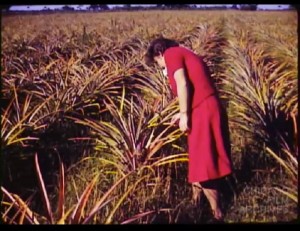
"2 part edited travelogue of the industries and everyday life in featured cities of Cuba. Part 1 begins in Havana before travelling to smaller cities, with a focus on buildings, crops and the everyday lives of the people. Part 2 primarily focuses on industry and includes scenes of a tile factory, basket weaving, as well as the farming of potatoes, sugar cane, bananas, and peanuts. The film also features historical monuments, boating, children at school, cock fights, vendors selling wares, and fishing. People demonstrate manual methods of labor like harvesting crops and cutting grass with machines lead by cattle." Chicago Film Archives.
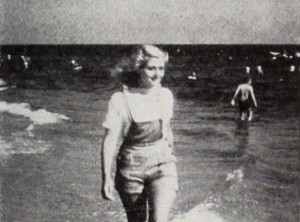
"Sunstruck, by George Mesaros, is a bright genre study of the American beach scene at its colorful, everyday best. There are the sun bathers and the sand babies, the athletes and the antics, and, above all else, the incomparably lithesome and lovely American girl. Mr. Mesaros has caught them all. in sparkling cinematography and with a pleasing selection of camera viewpoints. He has added to these a brace of brief and farcical skits which are well played and well directed. Sprightly music, shrewdly keyed to the varied sequences, rounds out the film's effect. Sunstruck, as suggested in its own foreword, is "gay, glamorous and often goofy."" Movie Makers, Dec. 1944, 496.
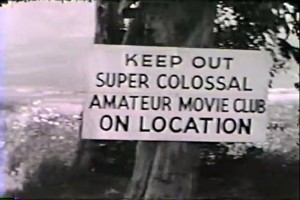
Comedic short film about an amateur movie club called Super Colossal Pictures.
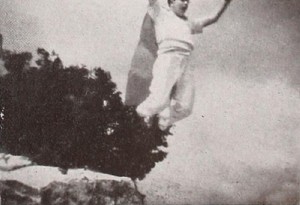
"Donald H. Kelly has cast a comic strip character in Superman Goes West, integrating travel sequences and comedy with great success. While the magnificent cinematographic record of a Western trip is the most engaging factor of the film, the entertainment value of the Superman motif cannot be minimized. The fictional hero is shown to be the consuming interest of a small boy passenger on the trip. The lad proceeds to read Superman comics under varying conditions, despite a changing background of allegedly awe inspiring scenery. One dream sequence with a Superman flavor is a triumph of trick cinematography." Movie Makers, Dec. 1943, 478.
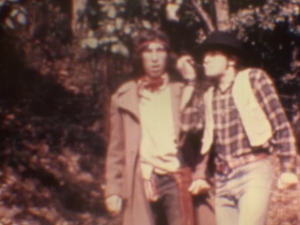
"El título venía del juego de palabras con "West/Oeste" que da origen a "western". Alegaba la posición sureña de México en relación con el viejo oeste estadounidense y por eso se llamaba Sur. Al inicio de la película, sobre el título, una voz en off se aseguraba de explicarlo "Sur: Un western de acá de este lado"" (Vázquez Mantecón, 2012).
"The title is a game with the words "West/Oeste", that originate the term "western". It pleads the southern position of Mexico regarding the old United States west, and that is why it was called Sur [South]. At the beginning of the film, above the title, an off voice makes sure to explain it "South: A western from this side"" (Vázquez Mantecón, 2012).
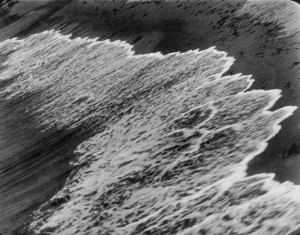
"Steiner is interested in film’s capacity to invigorate everyday sight, to alert viewers to the simple, magical visual pleasures available in nearly any circumstance. The film is divided into sequences that focus on specific kinds of imagery in and around ocean surf" Scott MacDonald via Light Cone.
"Honorable mention was also extended to J. Sherlock of Sydney, Australia, for his 'Surf, Sand and Sunshine,' a scenario picture of a day on the surf with a shark scare and a love theme welded into an interesting pictorial portrayal." American Cinematographer, Feb. 1936, 73.
"In Surgical Eradication of Pyorrhea, Dr. S. H. McAfee, ACL, made use of a very fine closeup technique and, in presenting the preliminary clinical information, plaster models played an important part. The work was shown step by step so that certain points could be watched more closely later on. The very difficult problem of lighting oral surgery for good photography was well handled and the resulting exposure and definition were eminently satisfactory." Movie Makers, Dec. 1933, 524.
"Film about a surprise party at the Woodley residence." Library and Archives Canada.
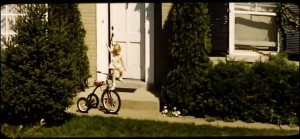
"Short wide screen amateur film made by George Ives, a Chicago Metro Movie Club member, and edited by Kenosha Cine Club member Ron Doerring. A corresponding 1/4" audio reel for this title is also housed at CFA, but has yet to be digitally transferred" Chicago Film Archives.
Total Pages: 299